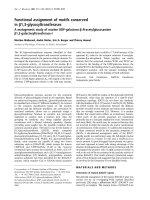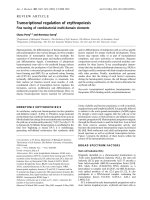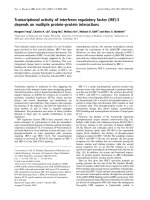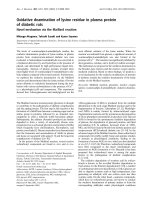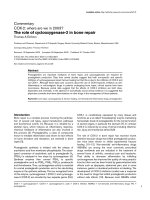Báo cáo y học: "Transcriptional control of dendritic patterning in Drosophila neurons" docx
Bạn đang xem bản rút gọn của tài liệu. Xem và tải ngay bản đầy đủ của tài liệu tại đây (97.29 KB, 4 trang )
Genome Biology 2006, 7:225
comment
reviews
reports deposited research
interactions
information
refereed research
Minireview
Transcriptional control of dendritic patterning in Drosophila
neurons
Michel Tassetto and Fen-Biao Gao
Address: Gladstone Institute of Neurological Disease, and Department of Neurology, University of California, San Francisco, CA 94158, USA.
Correspondence: Fen-Biao Gao. Email:
Abstract
How the morphology of individual neurons is controlled remains poorly understood. A recent
in vivo genome-wide screen based on RNA interference identified a large number of
transcriptional factors that regulate the stereotyped growth and branching of dendrites on some
Drosophila sensory neurons.
Published: 28 July 2006
Genome Biology 2006, 7:225 (doi:10.1186/gb-2006-7-7-225)
The electronic version of this article is the complete one and can be
found online at />© 2006 BioMed Central Ltd
Many neurons receive most of their input through thin
processes, called dendrites, that form synapses with the
axons of other neurons. Dendrites can be highly branched
and have complex architecture. The shape and size of the
dendrites of a single neuron determine the number and
specificity of the axonal contacts it receives. Therefore, the
development of the correct pattern of dendritic branching,
or arborization, on different neurons is essential for the
proper functioning of the nervous system. Neuronal sub-
types in mammals and insects can have specific patterns of
dendrite branching [1,2], and several unbiased genome-wide
‘forward’ genetic screens in Drosophila have identified
factors that regulate dendritic morphogenesis in both the
peripheral and central nervous systems [3-5]. But although
these studies uncovered dozens of genes that might have
essential roles in dendritic morphogenesis, most of the genes
have yet to be cloned and characterized, and the information
on genetic pathways has been sparse. Except for a few iden-
tified transcription factors that have been implicated in den-
dritic morphogenesis in flies and mammals [6-14], little is
known about the overall transcriptional programs that
specify the characteristic patterns of dendritic arborization
in different neurons.
Over the past few years, however, large-scale ‘reverse’
genetic approaches such as RNA interference (RNAi) have
emerged to help characterize molecular pathways. Screens
based on RNAi have been used to analyze cellular processes
in cultured insect cells [15,16] and in intact Drosophila
embryos [17,18]. In a recent paper in Genes and Develop-
ment, Parrish et al. [19] report the results of an in vivo
RNAi-based screen set up to examine transcription factor
networks that control several aspects of dendritic morpho-
genesis in Drosophila.
Identification of three functional groups of
transcription factors
Parrish and colleagues [19] took advantage of the simple and
stereotyped dendrite branching patterns of type I dendritic
arborization (DA) neurons in the Drosophila peripheral
nervous system. They prepared double-stranded RNAs
(dsRNA) representing 730 known and putative transcription
factors, injected them into early embryos, and screened for
dendritic defects at the end of embryogenesis. To avoid false
positives, only genes showing dendritic phenotypes as
assessed in several blind tests were chosen for further analy-
sis. Because the effectiveness of RNAi silencing could not be
systematically quantified, RNAi phenotypes were evaluated
qualitatively. The authors identified 76 genes for transcrip-
tional regulators that could be divided into three functional
groups (Figure 1). Group A comprises genes coding for
transcription factors that regulate dendrite outgrowth and
branching, and thus the size and complexity of a neuron’s
dendritic ‘field’. Group B includes genes with opposing effects
on dendrite outgrowth and dendrite branching. Group C
includes genes that specifically control the orientation of the
developing dendrites of embryonic type I DA neurons.
The 39 genes in group A were further divided into two sub-
groups. In one subgroup were 19 genes whose silencing
reduced the size of the dendritic field, indicating that these
genes normally promote both dendrite outgrowth and
branching. Although silencing of most of these genes
affected dendritic branching and outgrowth equally, RNAi of
the genes encoding the nuclear ecdysteroid hormone recep-
tors Ultraspiracle (Usp) and EcR (the ecdysone receptor),
appeared to affect mostly the extension of primary dendrites
without notably altering the number and length of lateral
branches. The second subgroup, of 20 genes, had opposing
functions to those of the first group, in that their normal
function appeared to be to limit both dendrite branching and
outgrowth. This group included the gene abrupt, which
restricts dendritic branching and outgrowth of type I DA
neurons [12,13], as well as other transcriptional regulators
with unknown function in neurons, such as Elongin c. Inter-
estingly, the second subgroup included four genes of the
same group of transcriptional regulators, the Polycomb
group. The downregulation of the genes - Su(z)12, E(z), esc
and Caf1 - resulted in increased dendritic branching and an
expanded dendritic field in type I DA neurons, suggesting that
the Polycomb group plays an important role in the trans-
criptional repression of dendrite outgrowth and branching.
Of the 21 genes in group B, the normal function of 19 appeared
to be to restrict the extension of the primary dendrite in favor
of lateral branch formation and outgrowth (see Figure 1b). In
contrast, the normal function of the two remaining genes, glial
cells missing 2 (gcm2) and the histone acetyltransferase gene
pcaf, appeared to be to promote primary dendrite extension
and restrict lateral branch formation, as their downregulation
caused increased lateral branching and decreased primary
dendrite extension. For both these genes, this phenotype was
observed only in one of the two type I DA neurons in the
dorsal cluster, the ddaE neurons. Whether the loss of function
of gcm2 and pcaf leads to the absence of ddaD neurons, the
other type I of DA neurons in the dorsal cluster, or to their
inability to extend any neurites (the growing ends of dendrites
or axons) is not clear. Nevertheless, the existence of these two
antagonistic transcriptional pathways suggests that the out-
growth of primary dendrites could inhibit the outgrowth of
lateral branches, and vice versa, and that transcriptional regu-
lation might be critical to the redistribution of the cellular
machinery for neurite extension from the main dendrite to the
lateral processes.
Finally, Parish et al. [19] identified ten transcription factor
genes (group C) that regulate the orientation of the growing
225.5 Genome Biology 2006, Volume 7, Issue 7, Article 225 Tassetto and Gao />Genome Biology 2006, 7:225
Figure 1
Schematic representation of the functions of each transcription factor
group in dendritic patterning of type I DA neurons in the Drosophila
peripheral nervous system. Subtypes of DA neurons have simple and
stereotyped branching patterns (the black neuron represents the ddaD
subtype and the gray neuron the ddaE subtype). (a) Group A genes fall
into two different subgroups. One group (19 genes) promotes overall
dendrite outgrowth (left), whereas the other (20 genes) inhibits overall
outgrowth (right). (b) Group B also includes genes with opposing
functions. Most of this group (19 genes) promote dendritic branching and
inhibit primary dendrite extension (left). The other two members inhibit
dendritic branching and promote primary dendrite extension (right).
(c) Group C genes (10 genes) influence the routing, or direction of
growth, of dendrites. The normal branching pattern is shown on the left.
The abnormal routing of dendrite lateral branches observed when a
group C gene is downregulated is shown on the right.
Inhibition of neurite outgrowth
Activation of neurite outgrowth
Dendrite routing
Key:
(b) Group B gene function
Subgroup 1 Subgroup 2
(c) Group C gene function
APAP
Normal
function
Effect of
downregulation
(a) Group A gene function
Subgroup 1 Subgroup 2
Primary
dendrite
Lateral
branch
Neuron
cell
body
ddaD ddaE
dendrites. The ddaD and ddaE neurons normally extend the
lateral branches of their dendrites towards the anterior and
posterior boundaries, respectively, of an embryonic body
segment. The silencing of the group C transcription factors
disrupted this pattern: in ddaE neurons, for example, lateral
branches even extended toward the anterior boundary of the
segment. Laser ablation of all other DA neurons in the dorsal
cluster did not affect the extension of lateral branches of
ddaE neurons toward the posterior segment boundary [20],
so it is possible that the orientation of these neurites is
mainly driven by extracellular attractive cues, and that group
C transcription factors regulate the expression of proteins
responsible for receiving and integrating these signals.
Pathways that might control dendrite
arborization
The formation of stereotyped dendritic arborization not only
requires overall dendrite outgrowth but also the coordina-
tion of the extension of the primary dendrite with the forma-
tion of lateral branches and with the direction of growth. On
the basis of RNAi phenotypes, Parrish and colleagues [19]
classified 76 transcription factors into three functional
groups that affect different aspects of dendrite arborization.
But is there any unity of mechanism behind the functional
unity of each group? The answer is likely to be yes. For
instance, several group A genes, such as those for the Poly-
comb group proteins and the nucleosome-remodeling
complex NURF, are associated with the regulation of Hox
gene expression [21]. Hox proteins are key developmental
transcription factors that control cell proliferation and dif-
ferentiation. Moreover, RNAi of group A genes resulted in
the highest rate of embryonic lethality, suggesting that these
transcription factors control basic pathways responsible for
general cell growth and survival. The vast majority of group
B genes identified in this screen control the balance between
primary dendrite outgrowth and lateral branching, and most
of them participate in protein complexes that repress tran-
scription. It is worth noting that runx1, the mammalian
homolog of the group B gene runt, regulates the diversifica-
tion of sensory neurons in mice [22]. Thus, Runx-family
transcription factors might be involved in both cellular iden-
tity and morphogenesis in vertebrate and invertebrate
peripheral nervous system neurons. Last but not least, three
of the ten group C genes encode components of the Brahma
protein complex, which regulates the expression of the sig-
naling protein Decapentaplegic (Dpp) in wing imaginal discs
[23], raising the possibility that some group C genes regulate
dendritic routing through a common molecular pathway.
Temporal action and relationships between the
different groups of transcription factors
Does this RNAi-based screen allow the characterization of all
transcription factors involved in dendritic arborization
among the 730 genes tested? The answer is probably no.
Indeed, when the authors reproduced their screen with
higher dsRNA concentrations, they identified three addi-
tional genes (bonus, stat92e, and rpd3) missed in their pre-
vious screen. This was presumably due to the difficulty of
silencing genes that have a high maternal contribution in the
embryo. And since the effectiveness of RNAi silencing could
not be quantified, other transcription factors involved in
dendritic morphogenesis might have been overlooked. Of
the 76 candidate genes that Parrish et al. [19] identified in
their screen, 32 have available mutant alleles and the
authors have analyzed the morphology of type I DA neurons
in these mutant flies. In most cases, the mutant alleles pro-
duced a phenocopy of the RNAi phenotype, validating the
accuracy of the approach. Analysis of the mutant flies
revealed that some of the candidate genes are also involved
in later stages of dendritic morphogenesis when type I DA
neurons do not extend new branches. Thus, some transcrip-
tion factors seem to be required to continuously maintain
the dendritic arborization and allow type I DA neurons to
retain their capacity to form new dendrites.
Identification of a large number of transcription factors
through reverse genetic screens offers an exciting opportu-
nity to map the transcriptional network that controls den-
dritic morphogenesis. Parrish et al. [19] also explored the
effect of simultaneously disrupting two group A genes with
opposite effects on dendrite outgrowth. The loss of function
of either of two genes normally required for dendrite exten-
sion was epistatic to the loss of abrupt, which normally
antagonizes overall dendrite outgrowth. The different group
A transcription factors are thus likely to positively or nega-
tively regulate a common set of target genes responsible for
overall dendrite extension. As outlined earlier, group B
genes can act as transcriptional switches between primary
dendrite outgrowth and lateral branch extension, and this
raises the question of the epistatic relationship between
these transcription factors and the group A genes that
control overall extension of the dendritic tree. In a further
experiment, the RNAi phenotype of four group A genes
appeared to override the mutant phenotype of the gene
senseless, which functionally belongs to both group B and
group C. The group A genes targeted here either promoted
or limited dendrite extension, suggesting that the loss of reg-
ulation of overall dendrite outgrowth is epistatic to the loss
of the correct balance between primary dendrite extension
and the extension of lateral branches.
To sum up, the RNAi-based screen carried out by Parrish et
al. [19] identified an extensive list of transcription factors
that regulate dendrite growth and the pattern of dendrite
arborization of type I DA neurons. Overlapping but distinct
sets of transcription factors may be required for dendritic
morphogenesis in other types of DA neurons in Drosophila.
As the dsRNAs were injected into early-stage embryos, which
are still in the syncytial stage, the cell-autonomous function
of these genes in either precursor cells or postmitotic neurons
comment
reviews
reports deposited research
interactions
information
refereed research
Genome Biology 2006, Volume 7, Issue 7, Article 225 Tassetto and Gao 225.3
Genome Biology 2006, 7:225
needs to be further assessed for a better understanding of
the mechanism of action of the transcription factors they
encode. Nevertheless, this comprehensive study offers a
powerful entry point to the task of dissecting the transcrip-
tional networks in postmitotic neurons and precursors that
are ultimately responsible for the morphology of each
subtype of DA neurons. Finally, most of the genes identified
in this screen have homologs in mammals. A recent screen
based on in situ hybridization characterized 349 transcrip-
tion factors with expression patterns restricted to different
anatomical regions of the mouse brain [24]. It will be inter-
esting to examine more closely all the transcription factors
identified in both screens with the aim of understanding
the transcriptional programs that regulate the dendrite
morphology of specific neuronal subtypes in mammals.
Acknowledgements
We thank S. Ordway and G. Howard for editorial assistance, and lab
members for comments. This work is supported by the NIH (F B.G.).
References
1. Masland RH: Neuronal cell types. Curr Biol 2004, 14:R497-R500.
2. Bodmer R, Jan YN: Morphological differentiation of the
embryonic peripheral neurons in Drosophila. Roux’s Arch Dev
Biol 1987, 196:69-77.
3. Gao FB, Brenman JE, Jan LY, Jan YN: Genes regulating dendritic
outgrowth, branching, and routing in Drosophila. Genes Dev
1999, 13:2549-2561.
4. Reuter JE, Nardine TM, Penton A, Billuart P, Scott EK, Usui T,
Uemura T, Luo L: A mosaic genetic screen for genes neces-
sary for Drosophila mushroom body neuronal morphogene-
sis. Development 2003, 130:1203-1213.
5. Medina PM, Swick LL, Andersen R, Blalock Z, Brenman JE: A novel
forward genetic screen to identify mutations affecting larval
neuronal dendrite development in Drosophila melanogaster.
Genetics 2006, 172:2325-2335.
6. Brenman JE, Gao FB, Jan LY, Jan YN: Sequoia, a tramtrack-related
zinc finger protein, functions as a pan-neural regulator for
dendrite and axon morphogenesis in Drosophila. Dev Cell
2001, 1:667-677.
7. Moore AW, Jan LY, Jan YN: hamlet, a binary genetic switch
between single- and multiple-dendrite neuron morphology.
Science 2002, 297:1355-1358.
8. Komiyama T, Johnson WA, Luo L, Jefferis GS: From lineage to
wiring specificity. POU domain transcription factors control
precise connections of Drosophila olfactory projection
neurons. Cell 2003, 112:157-167.
9. Grueber WB, Jan LY, Jan YN: Different levels of the home-
odomain protein cut regulate distinct dendrite branching
patterns of Drosophila multidendritic neurons. Cell 2003,
112:805-818.
10. Aizawa H, Hu SC, Bobb K, Balakrishnan K, Ince G, Gurevich I,
Cowan M, Ghosh A: Dendrite development regulated by
CREST, a calcium-regulated transcriptional activator.
Science 2004, 303:197-202.
11. Gaudilliere B, Konishi Y, de la Iglesia N, Yao G, Bonni A: A CaMKII-
NeuroD signaling pathway specifies dendritic morphogene-
sis. Neuron 2004, 41:229-241.
12. Li W, Wang F, Menut L, Gao FB: BTB/POZ-zinc finger protein
Abrupt suppresses dendritic branching in a neuronal
subtype-specific and dosage-dependent manner. Neuron 2004,
43:823-834.
13. Sugimura K, Satoh D, Estes P, Crews S, Uemura T: Development
of morphological diversity of dendrites in Drosophila by the
BTB-zinc finger protein abrupt. Neuron 2004, 43:809-822.
14. Hand R, Bortone D, Mattar P, Nguyen L, Heng JI, Guerrier S, Boutt
E, Peters E, Barnes AP, Parras C, et al.: Phosphorylation of
Neurogenin2 specifies the migration properties and the
dendritic morphology of pyramidal neurons in the neocortex.
Neuron 2005, 48:45-62.
15. Kiger AA, Baum B, Jones S, Jones MR, Coulson A, Echeverri C, Perri-
mon N: A functional genomic analysis of cell morphology
using RNA-interference. J Biol 2003, 2:27.
16. Echard A, Hickson GR, Foley E, O’Farrell PH: Terminal cytokine-
sis events uncovered after an RNAi screen. Curr Biol 2004,
14:1685-1693.
17. Ivanov AI, Rovescalli AC, Pozzi P, Yoo S, Mozer B, Li HP, Yu SH,
Higashida H, Guo V, Spencer M, Nirenberg M: Genes required for
Drosophila nervous system development identified by RNA
interference. Proc Natl Acad Sci USA 2004, 101:16216-16221.
18. Kim YO, Park SJ, Balaban RS, Nirenberg M, Kim Y: A functional
genomic screen for cardiogenic genes using RNA interfer-
ence in developing Drosophila embryos. Proc Natl Acad Sci USA
2004, 101:159-164.
19. Parrish JZ, Kim MD, Jan LY, Jan YN: Genome-wide analyses iden-
tify transcription factors required for proper morphogenesis
of Drosophila sensory neuron dendrites. Genes Dev 2006,
20:820-835.
20. Gao FB, Kohwi M, Brenman JE, Jan LY, Jan YN: Control of den-
dritic field formation in Drosophila: the roles of flamingo and
competition between homologous neurons. Neuron 2000,
28:91-101.
21. Muller J, Hart CM, Francis NJ, Vargas ML, Sengupta A, Wild B, Miller
EL, O’Connor MB, Kingston RE, Simon JA: Histone methyltrans-
ferase activity of a Drosophila Polycomb group repressor
complex. Cell 2002, 111:197-208.
22. Kramer I, Sigrist M, de Nooij JC, Taniuchi I, Jessell TM, Arber S: A
role for Runx transcription factor signaling in dorsal root
ganglion sensory neuron diversification. Neuron 2006,
49:379-393.
23. Marenda DR, Zraly CB, Dingwall AK: The Drosophila Brahma
(SWI/SNF) chromatin remodeling complex exhibits cell-
type specific activation and repression functions. Dev Biol
2004, 267:279-293.
24. Gray PA, Fu H, Luo P, Zhao Q, Yu J, Ferrari A, Tenzen T, Yuk DI,
Tsung EF, Cai Z, et al.: Mouse brain organization revealed
through direct genome-scale TF expression analysis. Science
2004, 306:2255-2257.
225.4 Genome Biology 2006, Volume 7, Issue 7, Article 225 Tassetto and Gao />Genome Biology 2006, 7:225
